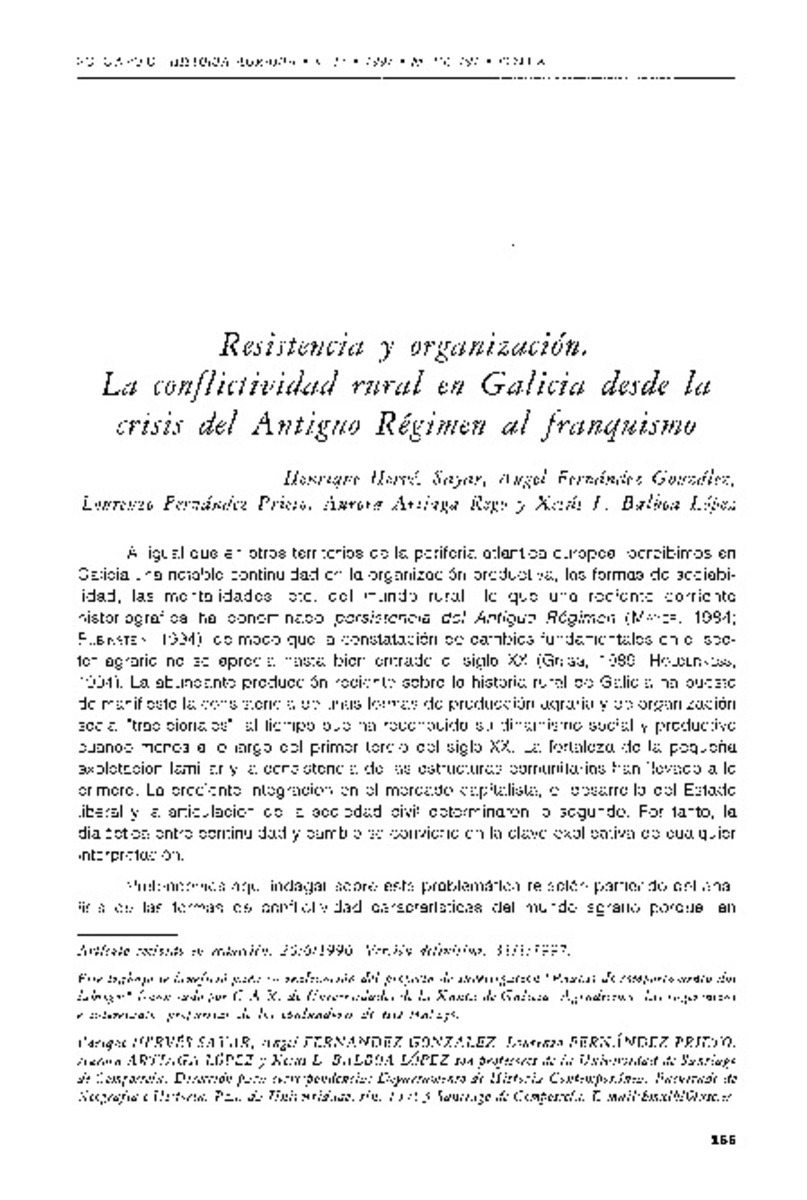Mostrar el registro sencillo del ítem
Resistencia y organización. La conflictividad rural en Galicia desde la crisis del Antiguo Régimen al franquismo
| dc.contributor.author | Hervés Sayar, Henrique | |
| dc.contributor.author | Fernández González, Ángel | |
| dc.contributor.author | Fernández Prieto, Lourenzo | |
| dc.contributor.author | Artiaga Rego, Aurora | |
| dc.contributor.author | Balboa López, Xesús | |
| dc.date.accessioned | 2016-05-10T10:07:23Z | |
| dc.date.available | 2016-05-10T10:07:23Z | |
| dc.date.issued | 1997-01 | |
| dc.identifier.issn | 1139-1472 | |
| dc.identifier.uri | http://hdl.handle.net/10234/159480 | |
| dc.description.abstract | En este artículo se hace una interpretación de la evolución de la conflictividad rural en Galicia en el largo plazo que va desde el momento anterior a la crisis del Antiguo Régimen hasta la segunda mitad del presente siglo. Se analiza el cambio en las formas de protesta y la naturaleza de los conflictos en la sociedad rural, en relación con los cambios impuestos por el desarrollo del capitalismo y la conformación del Estado liberal y teniendo en cuenta el mantenimiento de algunos rasgos estructurales que caracterizan la agricultura atlántica peninsular: fortaleza de la pequeña explotación familiar y vigencia de las estructuras comunitarias. La combinación de formas tradicionales y nuevas de protesta y de organización de la misma hace que la dialéctica entre continuidad y cambio se convierta en la clave explicativa de nuestra interpretación. Se describe y analiza por tanto el tránsito entre la articulación social comunitaria y la conformación de la sociedad civil contemporánea en una sociedad agraria típica de la periferia atlántica europea. | ca_CA |
| dc.description.abstract | This paper makes an interpretation about the evolution of rural conflict in Galicia in long term from the time before the Ancient Regime crisis to the second half of 20th Century. It analyses the change taking into account the ways of protesting and the conflict in the agrarian society in relation to the changes determinate by the development of capitalism and the building of the Liberal State. And also considering the preservation of some structural features that characterize the Iberian Atlantic agriculture: the dominance of small family farms and the strough of the rural community. Because of the combination of traditional and new forms of protest and organization, the continuity and change dialectic becomes one of the keys of this interpretation. It describes and analyses the change of a community social articulation into the construction of a modem civil society in a typical agrarian society of the European Atlantic periphery. | ca_CA |
| dc.format.extent | 27 p. | ca_CA |
| dc.format.mimetype | application/pdf | ca_CA |
| dc.language.iso | spa | ca_CA |
| dc.publisher | Sociedad Española de Historia Agraria (SEHA) | ca_CA |
| dc.relation.isPartOf | Historia agraria: Revista de agricultura e historia rural, nº 13, p. 165-191 | ca_CA |
| dc.rights | © SEHA | ca_CA |
| dc.rights.uri | http://rightsstatements.org/vocab/InC/1.0/ | * |
| dc.subject | conflictividad rural | ca_CA |
| dc.subject | periferia atlántica | ca_CA |
| dc.subject | articulación social | ca_CA |
| dc.subject | época contemporánea | ca_CA |
| dc.subject | rural conflict | ca_CA |
| dc.subject | atlantic periphery | ca_CA |
| dc.subject | social articulation | ca_CA |
| dc.subject | modern time | ca_CA |
| dc.title | Resistencia y organización. La conflictividad rural en Galicia desde la crisis del Antiguo Régimen al franquismo | ca_CA |
| dc.type | info:eu-repo/semantics/article | ca_CA |
| dc.rights.accessRights | info:eu-repo/semantics/openAccess | ca_CA |
| dc.relation.publisherVersion | http://www.historiaagraria.com/info_articulo.php?id=159 | ca_CA |







